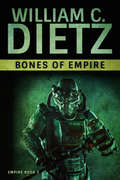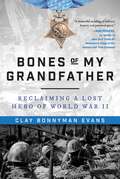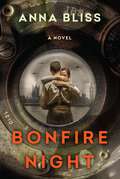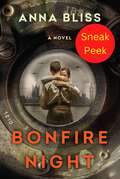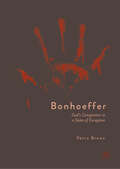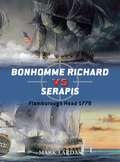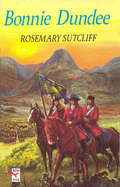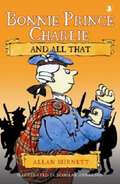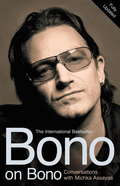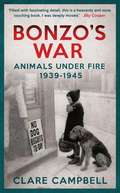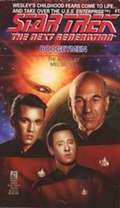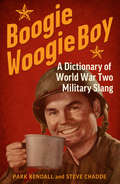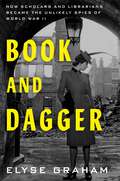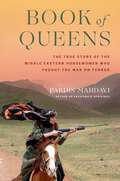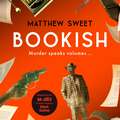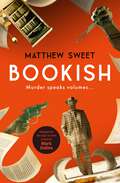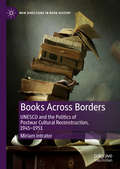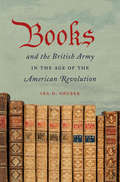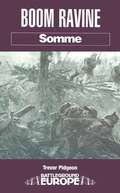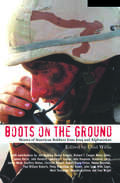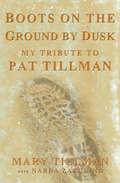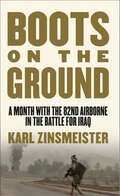- Table View
- List View
Bones of Empire (Empire #2)
by William C. DietzFrom the national bestselling author of Battle Hymn comes the conclusion to the electrifying sci-fi thriller duology begun with At Empire’s Edge…On the surface, the Uman Empire seems as glorious as ever, with its citizens reveling in their proud civilization, the Legions defending its borders, and the Emperor ruling benevolently over all. Yet it is a facade. In truth, the alien Vord are pushing deeper into Uman space even as the noble families maneuver for power within a waning Empire.But for Xeno Corps Centurion Jak Cato, all that matters is that he’s still alive. After a disastrous mission that almost cost him everything, he’s returning to the Imperial capital of Corin with his beloved Alamy for some well-deserved down time—which soon becomes no time.For as Cato watches a grand procession, he catches a glimpse of his mighty Emperor—and in one horrifying instant, Cato’s enhanced senses recognize that while the Emperor looks the same, it is not him. It is Fiss Verafti, the murderous Sagathi shape-changer Cato had just hunted down. The creature he thought was dead!As the Empire strains under attacks from within and without, Cato doggedly investigates the mystery of how Verafti made his way from the grave to the throne and who is behind the astounding plot. And when he does discover the truth, it will change Cato—and the entire galaxy—forever…“When it comes to military science fiction, William Dietz can run with the best.”—Steve Perry, author of the Matador series“Adrenaline-fueled, Clancy-esque adventure.”—Publishers Weekly
Bones of My Grandfather: Reclaiming a Lost Hero of World War II
by Clay Bonnyman Evans“War, reclamation, and what Tim O'Brien called "the Lives of the Dead" are eternal literary themes for men. Clay Bonnyman Evans has honored that lineage with this masterful melding of military history and personal quest.”—Ron Powers, co-author of New York Times #1 bestsellers Flags of Our Fathers and True Compass, along with No One Cares About Crazy People and othersIn November 1943, Marine 1st Lt. Alexander Bonnyman, Jr. was mortally wounded while leading a successful assault on a critical Japanese fortification on the Pacific atoll of Tarawa, and posthumously awarded the Medal of Honor, the nation's highest military honor. The brutal, bloody 76-hour battle would ultimately claim the lives of more than 1,100 Marines and 5,000 Japanese forces. But Bonnyman's remains, along with those of hundreds of other Marines, were hastily buried and lost to history following the battle, and it would take an extraordinary effort by a determined group of dedicated civilians to find him. In 2010, having become disillusioned with the U.S. government's half-hearted efforts to recover the "lost Marines of Tarawa," Bonnyman's grandson, Clay Bonnyman Evans, was privileged to join the efforts of History Flight, Inc., a non-governmental organization dedicated to finding and repatriating the remains of lost U.S. service personnel. In Bones of My Grandfather, Evans tells the remarkable story of History Flight's mission to recover hundreds of Marines long lost to history in the sands of Tarawa. Even as the organization begins to unearth the physical past on a remote Pacific island, Evans begins his own quest to unearth the reclaim the true history of his grandfather, a charismatic, complicated hero whose life had been whitewashed, sanitized and diminished over the decades. On May 29, 2015, Evans knelt beside a History Flight archaeologist as she uncovered the long-lost, well-preserved remains of of his grandfather. And more than seventy years after giving his life for his country, a World War II hero finally came home.
Bonfire Night: A Gripping And Emotional Ww2 Novel Of Star Crossed Love
by Anna Bliss&“A most tender work of art...Bonfire Night is a treasure of a novel, beautifully written with the unflinching style and subtle psychological insights of such masters as Ian McEwan and Graham Swift.&” –Natalie Jenner, internationally bestselling author of The Jane Austen Society and Bloomsbury GirlsSpanning from England's anti-fascism protests of 1936 through the aftermath of WWII, this moving, intricately wrought historical novel brings together a young Irish Catholic photographer and a British Jewish medical student, each discovering the price of love, art, and ambition…London, 1936: At twenty-one, Kate Grifferty is a press photographer in a Fleet Street agency, an unusual job for a young woman. But Kate is both talented and daring, recklessly going wherever the story might be—including, one October day, to an anti-fascism protest in East London. There, she meets David Rabatkin, a brilliant Jewish medical student. While his idealistic brother is eager to go to Spain and join the fight for the Republic, David knows where his path lies: at home, fulfilling the expectations of his profession and his family. Kate is exposed for the first time to the dangers and demands of David&’s world, where marrying within the Jewish faith is seen as not only preferable, but key to survival. Kate neither expects nor wants to be any man&’s wife, hampered by convention. And though she and David are both outsiders, as war looms, other differences between them are thrown into sharp relief.Brighton, 1940: Catastrophe forces Kate to flee London and the onslaught of war finds her working at her sister&’s seaside boarding house, while David tends patients at a busy London hospital as the Blitz rages. But Kate&’s challenges and disappointments have only deepened her desire to capture images of life unfurling around her, the beauty and violence, struggles and surprising joys. And soon fate and ambition will align, providing her with the chance to make her mark at last . . .
Bonfire Night: Sneak Peek
by Anna BlissBe one of the first to read this sneak preview sample edition before the full length novel comes out!&“A a most tender work of art...Bonfire Night is a treasure of a novel, beautifully written with the unflinching style and subtle psychological insights of such masters as Ian McEwan and Graham Swift.&” —Natalie Jenner, internationally bestselling author of The Jane Austen Society and Bloomsbury GirlsSpanning from England's anti-fascism protests of 1936 through the aftermath of WWII, this moving, intricately wrought historical novel brings together a young Irish Catholic photographer and a British Jewish medical student, each discovering the price of love, art, and ambition…London, 1936: At twenty-one, Kate Grifferty is a press photographer in a Fleet Street agency, an unusual job for a young woman. But Kate is both talented and daring, recklessly going wherever the story might be—including, one October day, to an anti-fascism protest in East London. There, she meets David Rabatkin, a brilliant Jewish medical student. While his idealistic brother is eager to go to Spain and join the fight for the Republic, David knows where his path lies: at home, fulfilling the expectations of his profession and his family.Kate is exposed for the first time to the dangers and demands of David&’s world, where marrying within the Jewish faith is seen as not only preferable, but key to survival. Kate neither expects nor wants to be any man&’s wife, hampered by convention. And though she and David are both outsiders, as war looms, other differences between them are thrown into sharp relief.Brighton, 1940: Catastrophe forces Kate to flee London and the onslaught of war finds her working at her sister&’s seaside boarding house, while David tends patients at a busy London hospital as the Blitz rages. But Kate&’s challenges and disappointments have only deepened her desire to capture images of life unfurling around her, the beauty and violence, struggles and surprising joys. And soon fate and ambition will align, providing her with the chance to make her mark at last . . .
Bonhoeffer: God’s Conspirator in a State of Exception
by Petra BrownTheologian. Conspirator. Martyr. Saint. Dietrich Bonhoeffer was killed in the waning days of World War II, having been implicated in the July 20th assassination attempt on Hitler. Since his death, Bonhoeffer’s life and writings have inspired contradictory responses. He is often seen as a model for Christian pacifist resistance, and more recently for violent direct political action. Bonhoeffer’s name has been invoked by violent anti-abortion protestors as well as political leaders calling for support on a ‘war on terror’ in the aftermath of 9/11. Petra Brown critically analyses Bonhoeffer’s writing preceding and during his conspiracy involvement, particularly his recurring concept of the ‘extraordinary.’ Brown examines this idea in light of ‘the state of exception,’ a concept coined by the one-time Nazi jurist and political theorist, Carl Schmitt. She also draws on the existentialist philosopher Sören Kierkegaard to consider what happens when discipleship is understood as obedience to a divine command. This book aims to complicate an unreflective admiration of Bonhoeffer’s decision for conspiracy, and draws attention to the potentially dangerous implications of his emerging political theology.
Bonhomme Richard vs Serapis
by Mark LardasThe clash between the American Bonhomme Richard and the British HMS Serapis during the American Revolutionary War is perhaps the most famous single-ship duel in history. This epic battle between two very similar ships - and crews - off the coast of Britain in September 1779 created two naval heroes: in victory John Paul Jones became a figure that all future American naval officers would aspire to emulate, while Richard Pearson, in defeat, became a hero to the British for a tenacious defense that allowed the merchant vessels under his protection to escape.In September 1779 five warships loosely commanded by John Paul Jones and sailing under the American flag - although all but one had all been loaned or donated by France, a key American ally - were moving down the Yorkshire coast when they encountered a Baltic merchant convoy of over 40 ships escorted by two British vessels, the Serapis and the Countess of Scarborough. A confused encounter battle culminated in the Bonhomme Richard, already severely damaged by British gunnery, deliberately colliding with the Serapis as John Paul Jones strove to board and capture the Royal Navy vessel before his own sank beneath him. The two ships continued to exchange devastating fire at point-blank range; an American grenade exploded on an arms chest on the Serapis, causing massive destruction on deck. Even so, the outcome of the battle remained inconclusive throughout the night until the British captain Richard Pearson, seeing that the merchant vessels under his protection had reached safety, reluctantly decided to surrender to his exhausted adversary. The Countess of Scarborough also surrendered, and the American squadron (minus the Bonhomme Richard, which promptly sank) were able to escape with their two prizes, observed by thousands of onlookers from the Yorkshire coastline.Featuring specially commissioned full-color artwork, this is the story of an epic maritime clash at the height of the Revolutionary War that provided a founding legend for generations of US naval officers and demonstrated the intrepidity and fighting prowess of the fledgling American Navy.
Bonnie Dundee
by Rosemary SutcliffIt is seventeenth-century Scotland, and the Covenanters – those wanting religious freedom from the dictates of English rule – are gathering strength. Hugh Herriott, fresh from a Covenanting background, finds himself working for redcoat Colonel Claverhouse and his Lady Jean: first as the stable-lad and in later years, as galloper to Claverhouse. The tension mounts between the two sides of the divided country. Claverhouse, with Hugh always by his side, leads his troops in bloody battle against the Covenanters, through forest and valley, village and town, victory… and loss.
Bonnie Prince Charlie and All That (The And All That Series)
by Allan BurnettA real-life adventure &“packed with humor&” and historical facts about Britain&’s royal rebel! (The School Librarian) Join the dashing Prince on a dangerous mission to win back his three kingdoms from the horrible Hanoverians. Scramble ashore in the Scottish Highlands and find out how Charlie uses his funny wig and fancy French accent to convince the warlike clans to follow him. Gallop into action as the Prince&’s fierce Jacobite soldiers skewer his enemies and capture their castles. Find out where things start going wrong—and decide what you&’d do if you were Charlie. Learn how dressing up like a girl helps the Prince avoid being turned into sausages by Butcher Cumberland. Smell the crackling gunpowder as Charlie and his clans charge into a showdown with their foes at the battle of Culloden—and find out what happens after the guns fall silent. Stuffed with superb illustrations, this brilliant book brings history life—and will have kids bounding through the heather on an exciting escapade.
Bono on Bono: Conversations with Michka Assayas
by Michka AssayasBono is one of the most influential musicians at work today. Over the past twenty-five years his band, U2, have sold a staggering 130 million albums and collected 14 Grammys. Their success has made Bono one of the most recognisable faces in the world.Here, in a series of conversations with his friend, the music journalist, Michka Assayas, Bono reflects on his transformation from extrovert singer of a small, Irish, post-punk band into an international rock star. Along the way he speaks candidly about his childhood, about his mother's death, about his Christian faith and about his difficult relationship with his father, who died recently. Bono also speaks passionately about how he has used his fame as a platform to campaign fervently on a range of global issues, and why these issues - which include the IRA ceasefire, Third World debt and, most recently, the growing AIDS crisis in Africa - are so important to each of us.Intimate, humorous, and fiercely opinionated, BONO ON BONO is Bono's story in his own words. It will fascinate and challenge fans of U2 and general readers alike.
Bonzo's War: Animals Under Fire 1939 -1945
by Clare CampbellWhat was it like to be a dog or cat when the world was at war? When food was rationed and cities were bombed? Pets (on the whole) do not write memoirs, so to find the answer to that question, Clare Campbell went in search of voices of those people whose lives were entwined with animals.She found stories - inspiring and harrowing - of animals under fire, of evacuated and homeless pets, of brave animals who provided comfort to humans while the bombs fell. Of pets unwittingly entangled in war, like the Dunkirk pets and the camp followers who switched sides to stay alive; and the 6,000 dogs recruited by the British Army - loaned for duty by their families - many never to return. Meanwhile with food in short supply, government officials launched a ruthless campaigns against pets... Thoroughly researched and deeply moving, Bonzo's War gives a fascinating account of, and platform for, the forgotten stories as yet unheard, of the creatures big and small caught up in a human conflict far beyond understanding.
Boocoo Death (The Black Eagles #8)
by John LansingWhen the only female member of the Black Eagles is captured by the North Vietnamese, Falconi and his squad follow after her, and are nearly cut to pieces in a trap.
Boogeymen (Star Trek: The Next Generation #17)
by Mel GildenEric Baldwin is the Federation's premier exologist, a specialist in all manner of alien life forms -- and one of Captain Picard's oldest, most trusted friends. But Baldwin's discoveries have made him enemies across the galaxy, and now he wants Picard to help him by erasing all traces of his existence. but Picard soon finds himself with little time to worry about Baldwin's problems. For the U.S.S. Enterprise . has suddenly become a strange and dangerous place -- a ship where assassins lurk in every corner, and even old trusted friends are not what they seem. Threats all masterminded by the strangest race of aliens Picard and his crew have yet encountered...
Boogie Woogie Boy: A Dictionary of World War Two Military Slang
by Kendall Park Steve ChaddeBoogie Woogie Boy, is a rich, unique source of hundreds of terms used by American and Allied servicemen and women in World War Two. The "slang" in the book is, by and large, humorous and paints a sometimes hilarious picture of life for the average GI, sailor, marine, or nurse. From "air corps chicken — a fowl that is all wings" to "Zeppelins in a fog — sausage and mashed potatoes," Boogie Woogie Boy is a fun-filled compendium, and also a valuable reference for readers of World War Two-era books, writers, playwrights, etc. Illustrated with ten cartoons.
Book and Dagger: How Scholars and Librarians Became the Unlikely Spies of World War II
by Elyse GrahamThe untold story of the academics who became OSS spies, invented modern spycraft, and helped turn the tide of the warAt the start of WWII, the U.S. found itself in desperate need of an intelligence agency. The Office of Strategic Services (OSS), a precursor to today’s CIA, was quickly formed—and, in an effort to fill its ranks with experts, the OSS turned to academia for recruits. Suddenly, literature professors, librarians, and historians were training to perform undercover operations and investigative work—and these surprising spies would go on to profoundly shape both the course of the war and our cultural institutions with their efforts.In Book and Dagger, Elyse Graham draws on personal histories, letters, and declassified OSS files to tell the story of a small but connected group of humanities scholars turned spies. Among them are Joseph Curtiss, a literature professor who hunted down German spies and turned them into double agents; Sherman Kent, a smart-mouthed history professor who rose to become the head of analysis for all of Europe and Africa; and Adele Kibre, an archivist who was sent to Stockholm to secretly acquire documents for the OSS. These unforgettable characters would ultimately help lay the foundations of modern intelligence and transform American higher education when they returned after the war.Thrillingly paced and rigorously researched, Book and Dagger is an inspiring and gripping true story about a group of academics who helped beat the Nazis—a tale that reveals the indelible power of the humanities to change the world.
Book of Queens: The True Story of the Middle Eastern Horsewomen Who Fought the War on Terror
by Pardis MahdaviThe untold story of generations of Middle Eastern freedom fighters—horsewomen who safeguarded an ancient breed of Caspian horse—and their efforts to defend their homelands from the Taliban and others seeking to destroy them."A breathtaking book that revisits nearly one hundred years of Iranian history, highlighting the power and beauty of women who refuse to be subdued.&” ―Alison Hawthorne Deming, author of A Woven WorldBook of Queens reaches back centuries to the Persian Empire and a woman disguised as a man, facing an invading army, protected only by light armor and the stallion she sat astride. Mahdavi draws a thread from past to present: from her fearless Iranian grandmother, who guided survivors of domestic violence to independent mountain colonies in Afghanistan where the women, led by a general named Mina, became their country&’s first line of defense from marauding warlords. To the female warriors who helped train and breed the horses used by US Green Berets when they touched down in October 2001, with a mission but insufficient intelligence on the ground—women whose contributions were then forgotten. Pardis Mahdavi chases the legacy of Caspian horses and the women whose lives are saved by them, drawing on decades of research, newly-discovered diaries, and exclusive military sources. Among those intersecting stories is that of American Louise Firouz, who helped bring the breed back from the brink of extinction, connecting Virginia traders to British royals to the son of the Shah. Firouz&’s life is forever changed when she meets Mahdavi&’s own family, who run an unusual smuggling operation in addition to raising horses in a wild bid for freedom.Book of Queens is an epic tale of hidden women whose communal knowledge was instrumental in saving an animal as ancient as civilization, and who were the genesis of their own liberation.
Bookish: a witty, warm-hearted mystery perfect for book lovers (Bookish)
by Matthew SweetAdapted from the upcoming major U&alibi series created by Mark GatissLondon, 1946. Gabriel Book is an erudite and unconventional London bookseller married to Trottie, the owner of the wallpaper shop next door. He is also a sleuth who uses the chaotic riches of his stock to crack the puzzling cases that come his way. He does not work alone. Book's shop is a magnet for waifs and strays - some of whom bring mysteries of their own to his door. There's Nora, sometime bookseller and true crime enthusiast; Dog, connoisseur of ginger biscuits and then Jack, whose arrival at the shop forces Book to confront a loose end from his own past.Clever, endearing and entertaining, Bookish is a warm-hearted and unexpected mystery, about books, murder and the secrets we all keep.
Bookish: a witty, warm-hearted mystery perfect for book lovers (Bookish)
by Matthew SweetAdapted from the upcoming major U&alibi series created by Mark GatissGabriel Book is an erudite and unconventional London bookseller married to Trottie, the owner of the wallpaper shop next door. He is also a sleuth who uses the chaotic riches of his stock to crack the puzzling cases that come his way. He does not work alone. Book's shop is a magnet for waifs and strays - some of whom bring mysteries of their own to his door. There's Nora, sometime bookseller and true crime enthusiast; Dog, connoisseur of ginger biscuits and then Jack, whose arrival at the shop forces Book to confront a loose end from his own past.Clever, endearing and entertaining, Bookish is a warm-hearted and unexpected mystery, about books, murder and the secrets we all keep.
Bookish: a witty, warm-hearted mystery perfect for book lovers (Bookish)
by Matthew SweetAdapted from the upcoming major U&alibi series created by Mark GatissLondon, 1946. Gabriel Book is an erudite and unconventional London bookseller married to Trottie, the owner of the wallpaper shop next door. He is also a sleuth who uses the chaotic riches of his stock to crack the puzzling cases that come his way. He does not work alone. Book's shop is a magnet for waifs and strays - some of whom bring mysteries of their own to his door. There's Nora, sometime bookseller and true crime enthusiast; Dog, connoisseur of ginger biscuits and then Jack, whose arrival at the shop forces Book to confront a loose end from his own past.Clever, endearing and entertaining, Bookish is a warm-hearted and unexpected mystery, about books, murder and the secrets we all keep.
Books Across Borders: UNESCO and the Politics of Postwar Cultural Reconstruction, 1945–1951 (New Directions in Book History)
by Miriam IntratorBooks Across Borders: UNESCO and the Politics of Postwar Cultural Reconstruction, 1945-1951 is a history of the emotional, ideological, informational, and technical power and meaning of books and libraries in the aftermath of World War II, examined through the cultural reconstruction activities undertaken by the Libraries Section of the United Nations Educational, Scientific and Cultural Organization (UNESCO). The book focuses on the key actors and on-the-ground work of the Libraries Section in four central areas: empowering libraries around the world to acquire the books they wanted and needed; facilitating expanded global production of quality translations and affordable books; participating in debates over the contested fate of confiscated books and displaced libraries; and formulating notions of cultural rights as human rights. Through examples from France, Poland, and surviving Jewish Europe, this book provides new insight into the complexities and specificities of UNESCO’s role in the realm of books, libraries, and networks of information exchange during the early postwar, post-Holocaust, Cold War years.
Books and the British Army in the Age of the American Revolution
by Ira D. GruberHistorians have long understood that books were important to the British army in defining the duties of its officers, regulating tactics, developing the art of war, and recording the history of campaigns and commanders. Now, in this groundbreaking analysis, Ira D. Gruber identifies which among over nine hundred books on war were considered most important by British officers and how those books might have affected the army from one era to another. By examining the preferences of some forty-two officers who served between the War of the Spanish Succession and the French Revolution, Gruber shows that by the middle of the eighteenth century British officers were discriminating in their choices of books on war and, further, that their emerging preference for Continental books affected their understanding of warfare and their conduct of operations in the American Revolution. In their increasing enthusiasm for books on war, Gruber concludes, British officers were laying the foundation for the nineteenth-century professionalization of their nation's officer corps. Gruber's analysis is enhanced with detailed and comprehensive bibliographies and tables. Historians have long understood that books were important to the British army in defining the duties of its officers, regulating tactics, developing the art of war, and recording the history of campaigns and commanders. Now, in this groundbreaking analysis, Ira D. Gruber identifies which among over nine hundred books on war were considered most important by British officers and how those books might have affected the army from one era to another. By examining the preferences of some forty-two officers who served between the War of the Spanish Succession and the French Revolution, Gruber shows that by the middle of the eighteenth century British officers were discriminating in their choices of books on war and, further, that their emerging preference for Continental books affected their understanding of warfare and their conduct of operations in the American Revolution. In their increasing enthusiasm for books on war, Gruber concludes, British officers were laying the foundation for the nineteenth-century professionalization of their nation's officer corps. Gruber's analysis is enhanced with detailed and comprehensive bibliographies and tables.
Boom Ravine: Somme (Battleground Europe)
by Trevor PidgeonThe principal action that took place here in February 1917 was of short duration and failure but with fascinating overtones. This is the dramatic story of the events on the Somme after the great battle of 1916 ended and before the Germans withdrew to the Hindenburg Line. Its focus is on a ravine easily as impressive as that at Beaumont Hamel.
Boots On the Ground: Stories of American Soldiers from Iraq and Afghanistan
by Clint WillisThe recent wars in Iraq and in Afghanistan have generated gripping coverage from some of our most accomplished writers and correspondents, and Boots on the Ground collects the best new writing about our troops in the field. They include Mike Sager, who profiles marines training in the California desert for war in Afghanistan; John Laurence, who follows the elite 101st Airborne into a firefight at Baghdad airport; Evan Wright, who files a dispatch from Afghanistan with Canadian and American reconnaissance teams; Peter Boyer and David Levine, who explore the resignation of U. S. Marine Reserve Corps Major Scott Ritter from the United Nations arms inspection team sent to Iraq. These writers' stories offer new and deeper perspectives on the challenges and setbacks our soldiers face in modern combat, and together create a gripping portrait of the front lines in the ongoing war against terrorism.
Boots on the Ground by Dusk: My Tribute to Pat Tillman
by Mary Tillman Narda ZacchinoOn April 22, 2004, Lieutenant David Uthlaut received orders from Khost, Afghanistan, that his platoon was to leave the town of Magarah and "have boots on the ground before dark" in Manah, a small village on the border of Pakistan. It was an order the young lieutenant protested vehemently, but the commanders at the Tactical Command Center disregarded his objections. Uthlaut split his platoon into two serials, with serial one traveling northwest to Manah and serial two towing a broken Humvee north toward the Khost highway. By nightfall, Uthlaut and his radio operator were seriously wounded, and an Afghan militia soldier and a U.S. soldier were dead. The American soldier was Pat Tillman. The Tillman family was originally informed that Pat, who had given up a professional football career to serve his country, had been shot in the head while getting out of a vehicle. At his memorial service twelve days later, they were told that he was killed while running up a hill in pursuit of the enemy. He was awarded a Silver Star for his courageous actions. A month and two days after his death, the family learned that Pat had been shot three times in the head by his own troops in a "friendly fire" incident. Seven months after Pat's death, the Tillmans requested an investigation.Boots on the Ground by Dusk is a chronicle of their efforts to ascertain the true circumstances of Pat's death and the reasons why the Army gave the family and the public a false story. Woven into the account are valuable and respectful memories of Pat Tillman as a son, brother, husband, friend, and teammate, in the hope that the reader will better comprehend what is really lost when our sons and daughters are killed or maimed in war. In the course of three and a half years, there have been six investigations, several inquiries, and two Congressional hearings. The Tillmans are still awaiting an outcome.
Boots on the Ground: A Month with the 82nd Airborne in the Battle for Iraq
by Karl ZinsmeisterKarl Zinsmeister's Boots on the Ground includes 32 color photographs taken by the author during the month he was embedded with the 82nd in Kuwait and Iraq.This is a riveting account of the war in Iraq moving north with the 82nd Airborne. Units of the 82nd depart Kuwait and convoy to Iraq's Tallil Air Base en route to night-and-day battles within the major city of Samawah and its intact bridges across the Euphrates. Boots on the Ground quickly becomes an action-filled microcosm of the new kinds of ultramodern war fighting showcased in the overall battle for Iraq. At the same time it remains specific to the daily travails of the soldiers. Karl Zinsmeister, a frontline reporter who traveled with the 82nd, vividly conveys the careful planning and technical wizardry that go into today's warfare, even local firefights, and he brings to life the constant air-ground interactions that are the great innovation of modern precision combat.What exactly does it feel like to travel with a spirited body of fighting men? To come under fire? To cope with the battlefield stresses of sleep-deprivation, and a steady diet of field rations for weeks on end? Readers of this day-to-day diary are left with not only a flashing sequence of strong mental images, but also a notion of the sounds and smells and physical sensations that make modern military action unforgettable. Ultimately, Boots on the Ground is a human story: a moving portrayal of the powerful bonds of affection, trust, fear, and dedication that bind real soldiers involved in battle. There are unexpected elements: The humor that bubbles up amidst dangerous fighting. The pathos of a badly wounded young boy. The affection openly exhibited by many American soldiers--love of country, love of family and hometown, love of each other. This is a true-life tale of superbly trained men in extraordinary circumstances, packed with concrete detail, often surpassing fiction for sheer drama.
